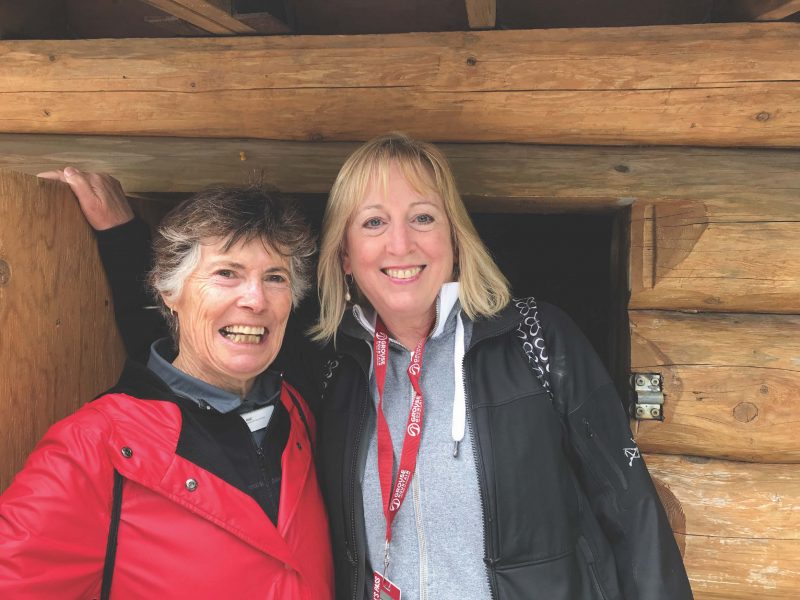#616 Captive mountain grizzlies
The Grizzlies of Grouse Mountain: The True Adventures of Coola and Grinder
by Shelley Hrdlitschka and Rae Schidlo, illustrated by Linda Sharp
Victoria: Heritage House, 2019
$19.95 / 9781772032772
Reviewed by Theo Dombrowski
*
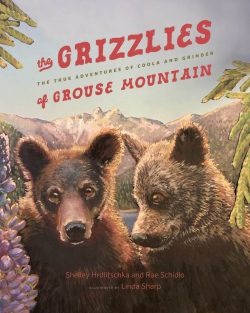 Grizzly bear! Ursus arctos ! Or is it, more correctly, Ursus arctos horribilis? The first is the species name, the second the subspecies name. A glance at the two loveable cubs on the cover of a recent non-fiction children’s book makes it easy to guess which one its authors choose to give. Like much else in this book — clearly a labour of love — it reveals a lot about decisions made by its two authors and its illustrator, namely to ignore, gently, the horribilis nature of the subspecies.
Grizzly bear! Ursus arctos ! Or is it, more correctly, Ursus arctos horribilis? The first is the species name, the second the subspecies name. A glance at the two loveable cubs on the cover of a recent non-fiction children’s book makes it easy to guess which one its authors choose to give. Like much else in this book — clearly a labour of love — it reveals a lot about decisions made by its two authors and its illustrator, namely to ignore, gently, the horribilis nature of the subspecies.
First off, though, for readers not familiar with the story (much repeated in Vancouver news media), these are the essentials. In 2001, two orphaned grizzly cubs, one from British Columbia’s north coast, one from the interior, were taken into care. A veterinarian, hearing about them, initiated the building of a refuge high on Vancouver’s Grouse Mountain (in winter a ski resort). Since then, their growth and behaviour has been closely observed, directly by the public in summer and indirectly by infrared camera during the winter months of “dormancy” (not quite hibernation.) Local media and tourist sites seem to be particularly taken with reporting and photographing the grizzlies’ coming out of dormancy in the spring.
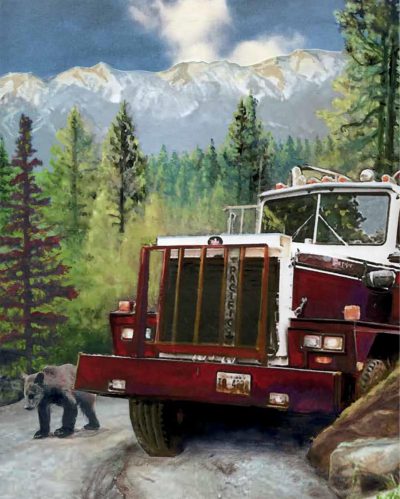
Besides not using the term “horribilis,” the authors have, calculatedly, left out other bits and pieces of information. First, they keep their focus very much on the bears rather than on the humans involved in their wellbeing. From the loggers who found one cub, to the vet who initiated the building of the refuge, to the “human caregivers” who look after the bears, all remain shadowy. Some of them are named in the Acknowledgements, but none in the story itself.
More strikingly, though, the authors decide not to report, for example, that two other cubs were (briefly) brought to the shelter in 2002, or that an attempt to integrate wolves into the shelter led to a violent end when, in full view of the public, one of the bears dispatched the wolf. Understandably, too, the book skirts other uncomfortable issues, like the facts that, before this attempt at sheltering the animals, orphaned grizzlies were (apparently) killed, or that some animal activists have questioned the nature of the programme.
Further to create a positive mood, the authors generally choose to write as if they were narrating a tale. The book begins, “A tiny grizzly bear cub stumbled out of the forest and lurched across the logging road.” Throughout, the writing style is simple and the tone quiet:
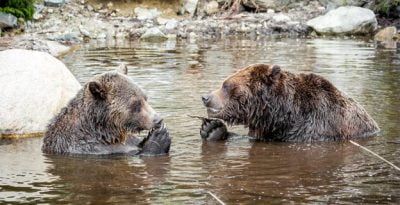
They enjoy each other’s company. Even when they sleep they are usually side by side…..
Sometimes they play fight with their huge mouths open, trying to grab the other’s thick fur around the neck. Sometimes Grinder is like a pesky young brother and invades Coola’s space even when Coola is napping.
The story of the grizzlies emphasizes their endearing behaviour. They tussle and tease, they bob for roots in a pond, they float on their backs while grabbing their toes.
Also reinforcing the book’s steady calm is the fact that much of the content — not the form — would sit comfortably in a magazine or newspaper. In fact, some younger readers (at least based on four samples!) may find the book a little fact-based, a little external. Indeed, some sections sound almost text bookish: “Coastal bears … tend to be bigger than interior bears …. because their diet includes more protein, mainly in the form of salmon.”
Considered only as a book to engage children and to fulfil no other purpose, The Grizzlies of Grouse Mountain is targeted toward a particular kind of child. Most enthusiasts of children’s literature (and both authors have had experience, one as an author) recognize that many children are most engaged when they shake in their boots. From Grimm’s fairy tales to Disney classics, children’s eyes pop and their hearts race as they encounter the horrible and, yes, grisly. Some young readers of a book about grizzlies would no doubt love to be just a little frightened. Killing a wolf stone cold with a single swipe of a giant, clawed foreleg, for example, would be exactly the kind of stuff that would do the trick.
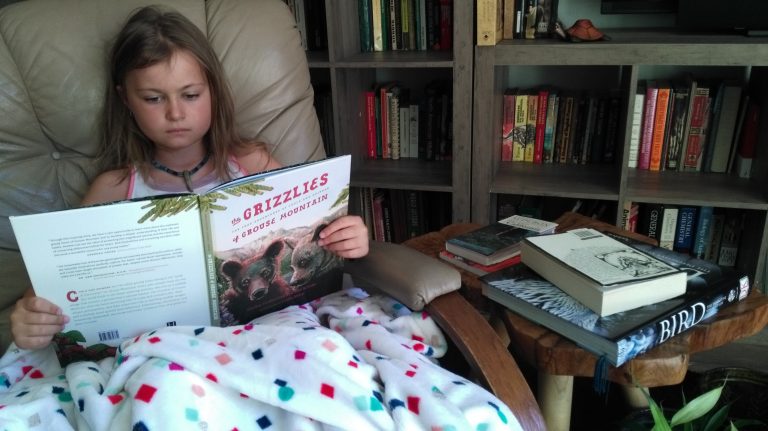
Another decision made by the authors that suggests their aiming at particular kind of reader, is not to engage in imaginative speculation or to enter the point of view of the animals. The writers of children’s fiction, of course, generally do both. A writer of children’s fiction is likely to have invented a narrative about the way each cub experienced the joys and terrors of the first months of life, and, even more, how each suffered a harrowing loss of mother and siblings, all through the animals’ eyes.
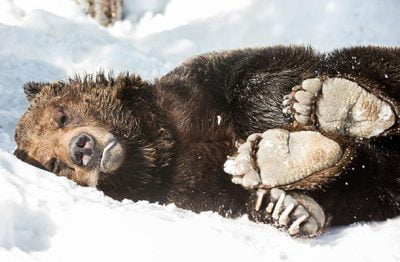
The Grizzlies of Grouse Mountain uses no such tactics. Indeed, doing so would have betrayed the basic principles of authenticity that the writers embrace.
Consider the main purpose of the book. The book is not dedicated to children, but “wildlife conservationists everywhere” (not even “young conservationists”). The authors keep their gaze firmly on the goal of motivating readers to become involved in the welfare of grizzlies, yes, but to do so without sensationalizing, or (much) sentimentalizing — selecting to the point of skewing reality a little, but not actually giving sway to full-on imaginative recreation or anthropomorphizing. Though the bears have names, the authors carefully say they were “given” the names.
The closest the authors come to betraying this objectivity is in a photofolder that comes as a kind of appendix. Here, photos of the bears with striking expressions are captioned with speech bubbles the way humorous scrap-bookers apply captions to photos of venerable aunts and bemused babies. The joke here, though, is arguably chiefly on those who dibble with photos.
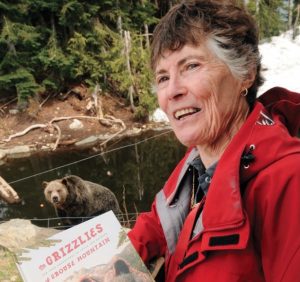
The conservationist project is further reflected in the inclusion of two graphically colourful maps and a list of grizzly facts, headed “Did You Know?” With these diversions the authors take additional steps to develop a relish for the solid reality lying behind both the particular circumstances of these two grizzlies, and grizzlies in general. To know them, as we appreciate, is to love them.
Again, though, it is clear that in selecting the particular facts to report, the authors wish to emphasize only fairly benign biological features. We like, and want to protect, that which we know, understand, and find fascinating.
It is obvious why facts about the crushing strength of the jaws (Wikipedia reports 84 kg per square centimetre!), the killing power of a swipe of heavily clawed forelegs, or the battles to the death of male grizzlies are not included in the “Did You Know?” section. It is additionally obvious why the authors steer well clear of any “facts” about human/bear interactions. The news media and Hollywood, after all, do an enthusiastic job of reporting nightmare-inducing details of bear attacks. Think: horriblis.
Clearly, this book’s driving force is to record the efforts of the Grouse Mountain project, yes, but also to propel the principles of wildlife conservation. Using a calmly narrated, feel-good children’s book as the conduit for both of these seems a reasonable method. From a purely conservationist point of view, however, the selection of grizzlies as subject matter raises some issues. Indeed, some conservationists feel that focusing on “charismatic megafauna” can distract from the need for broad-reaching conservation. (e.g. https://theweek.com/articles/450037/why-want-save-whales-but-not-crickets).
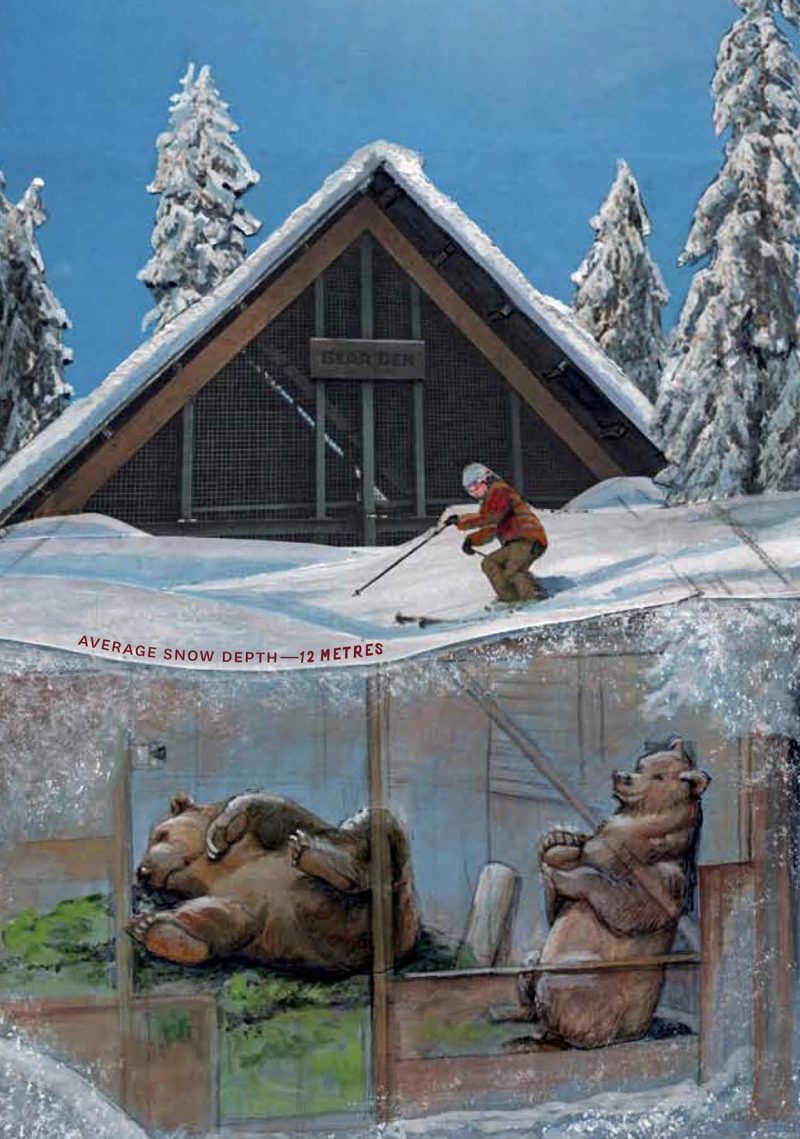
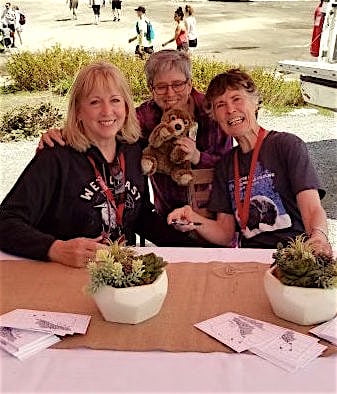
From a Canadian perspective, of course, it is polar bears, not grizzlies, that are the main poster boys (and mammas) of the conservation movement, though orcas, “spirit bears,” woodland caribou, and grizzlies do crowd eagerly into the media. In contrast, the bat populations decimated by white-nose syndrome don’t exactly hit the headlines. As for freshwater mussels, the Olympia oyster, or the American eel — all endangered species in Canada — you don’t have to be a media expert to calculate the odds of any of them focusing laser beams of popular conservationist energy, let alone becoming the topic of a children’s book.
Both as a children’s book and conservationist project, this is, of course, illustrated. The same kind of attempt to balance factual reality with charm that underlies the writing, is reflected in the copious and detailed illustrations. The illustrations, in fact, are at least as much a labour of love as the writing. Any reader who has made even a passing attempt at daubing a bit of paint on canvas will appreciate the vast labour that has been lavished on the detailed illustrations. Not just the bears themselves — and their densely detailed fur, for example — but the trees and plants, are often given a (roughly) photographic treatment. It is not surprising to read that photographs “informed” the illustrations (though what that means is a little unclear.) Most of the illustrations, in fact, have the look of being replications of photos, some more successful than others. Some of the illustrations, further, are an unusual montage of photos (usually foliage) and painting, almost with the appearance of a scrapbook.
Noticeably, again, the illustrations implicitly encourage children to find bears charming rather than grisly. Like the writing, the illustrations are gentle, calm and a little misleading. The artist seems to have made the cubs’ eyes slightly larger than mother nature designed, and captured their faces as mostly winsome or even smiling, sometimes framed by flowers or berries. They are shown snoozing, tussling, or eating. Who wouldn’t want to protect creatures like these?
Clearly, this is the kind of book that will especially appeal to those who have been to the Grouse Mountain centre or hope to go. It tells an interesting story carefully and calmly. Unquestionably sincere and well-motivated, it will mostly engage children who love animals and like to know more about these grizzlies, rather than those who want a story of danger, comedy, or feats propelled by magic or superpowers. Doting grandparents will happily snap it up as a memento after an outing to the refuge, later packaging it up as a gift to appear at a birthday party or under a tree.
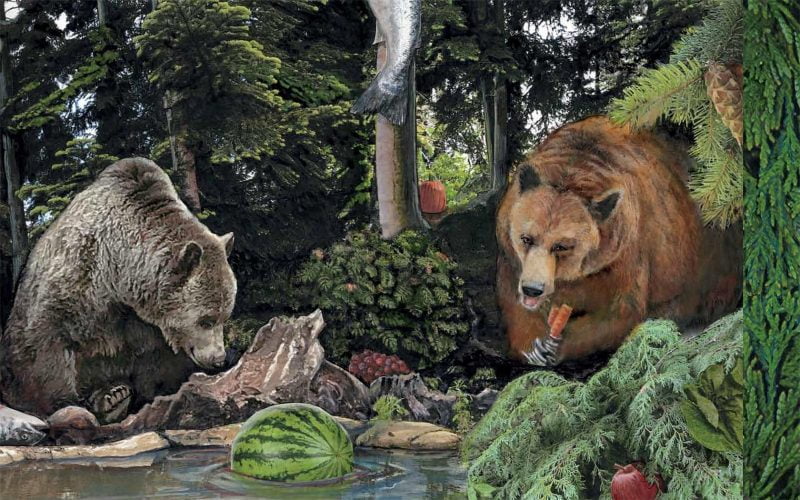
*

Born on Vancouver Island, Theo Dombrowski grew up in Port Alberni and studied at the University of Victoria and later in Nova Scotia and London, England. With a doctorate in English literature, he returned to teach at Royal Roads, the University of Victoria, and finally at Lester Pearson College at Metchosin. He also studied painting and drawing at the Banff School of Fine Arts and at UVic. Theo Dombrowski is the author and illustrator of popular guide, travel, and hiking books including Secret Beaches of the Salish Sea (Heritage House, 2012), Seaside Walks of Vancouver Island (Rocky Mountain Books, 2016), and Family Walks and Hikes of Vancouver Island — Volume 1: Victoria to Nanaimo, and Volume 2: Nanaimo North to Strathcona Park (Rocky Mountain Books, 2018), reviewed by Chris Fink-Jensen in The Ormsby Review no. 384, September 25, 2018, and a Kindle book, When Baby Boomers Retire: Getting the Full Scoop. You can learn more about him from his website. Theo lives at Nanoose Bay.
*
The Ormsby Review. More Books. More Reviews. More Often.
Publisher and Editor: Richard Mackie
The Ormsby Review is a journal service for serious coverage of B.C. books and authors, hosted by Simon Fraser University. The Advisory Board consists of Jean Barman, Robin Fisher, Cole Harris, Wade Davis, Hugh Johnston, Patricia Roy, David Stouck, and Graeme Wynn. Scholarly Patron: SFU Graduate Liberal Studies. Honorary Patron: Yosef Wosk. Provincial Government Patron since September 2018: Creative BC
“Only connect.” – E.M. Forster
